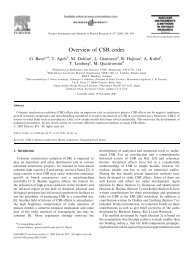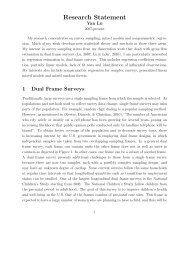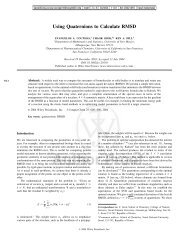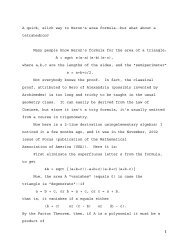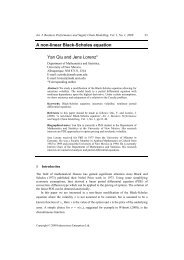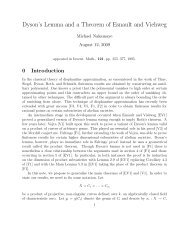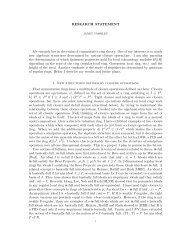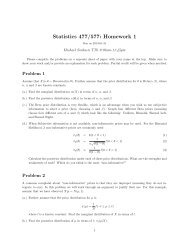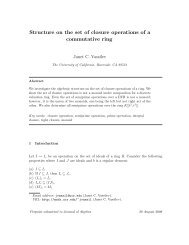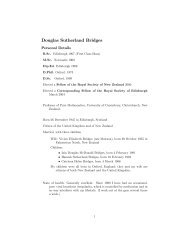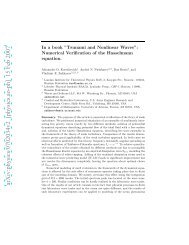OEO Office of Equal Opportunity - Department of Mathematics and ...
OEO Office of Equal Opportunity - Department of Mathematics and ...
OEO Office of Equal Opportunity - Department of Mathematics and ...
You also want an ePaper? Increase the reach of your titles
YUMPU automatically turns print PDFs into web optimized ePapers that Google loves.
EARTH AND PLANETARY SCIENCES 177<br />
574L. Hydrogeology Laboratory. (1) Weissmann<br />
Laboratory <strong>and</strong> field exercises in subsurface hydrology: physical<br />
properties <strong>of</strong> porous media, flow net analysis, groundwater<br />
basin storage <strong>and</strong> recharge, pump <strong>and</strong> piezometer tests,<br />
well design, sampling.<br />
Pre- or corequisite: 462 or C E 441.<br />
575. Advanced Volcanology. (3)<br />
Dynamics <strong>of</strong> volcanic eruptions, monitoring <strong>of</strong> volcanic hazards,<br />
geothermal energy, epithermal, numerical <strong>and</strong> analytical<br />
research techniques.<br />
Prerequisite: 450L.<br />
576./476. Physical Hydrology. (3)<br />
(Also <strong>of</strong>fered as WR 576.) Quantitative treatment <strong>of</strong> the<br />
hydrologic cycle—precipitation, evapotranspiration, run<strong>of</strong>f<br />
<strong>and</strong> subsurface flow; global change <strong>and</strong> hydrology; catchment<br />
<strong>and</strong> hillslope hydrology; hydrologic system—ecosystem<br />
interactions; hydrology <strong>and</strong> water resources management.<br />
Prerequisites: upper-division st<strong>and</strong>ing, MATH 163, PHYC<br />
160. {Fall}<br />
580. Advanced Hydrogeology. (3)<br />
Advanced treatment <strong>of</strong> subsurface fluid flow <strong>and</strong> other transport<br />
phenomena through granular <strong>and</strong> fractured media.<br />
Prerequisites: (462 or C E 441) <strong>and</strong> MATH 264.<br />
581L./481L. Geomorphology <strong>and</strong> Surficial Geology. (4)<br />
Meyer<br />
Origin <strong>and</strong> development <strong>of</strong> l<strong>and</strong>forms with emphasis on<br />
weathering, soils, hillslope processes, fluvial systems <strong>and</strong><br />
surficial geology; occasional field trips. Intro to Geology or<br />
Environmental Science recommended.<br />
582L./482L. Geoarchaeology. (3) Smith<br />
(Also <strong>of</strong>fered as ANTH 582L.) Application <strong>of</strong> geological<br />
concepts to archaeological site formation with emphasis on<br />
pre-ceramic prehistory <strong>of</strong> the southwestern United States.<br />
Quaternary dating methods, paleoenvironment, l<strong>and</strong>scape<br />
evolution, depositional environments. Quaternary stratigraphy,<br />
soil genesis, sourcing <strong>of</strong> lithic materials, site formation<br />
processes. Required field trip.<br />
Prerequisites: 101, 105L, ANTH 121L, ANTH 220 <strong>and</strong> at least<br />
junior st<strong>and</strong>ing in EPS or Anth. {Spring}<br />
584. Soil Genesis. (3) McFadden<br />
Processes <strong>of</strong> physical <strong>and</strong> chemical weathering; influence<br />
<strong>of</strong> soil parent materials, climate topography <strong>and</strong> time on soil<br />
formation; application <strong>of</strong> soil studies to geologic problems.<br />
Prerequisites: 101 or ENVS 101, 481L.<br />
585L./485L. Soil Stratigraphy <strong>and</strong> Morphology. (3)<br />
McFadden<br />
Application <strong>of</strong> soils studies to stratigraphic analysis <strong>and</strong><br />
mapping <strong>of</strong> Quaternary deposits <strong>and</strong> geomorphic surfaces;<br />
survey <strong>of</strong> soil classifications; field description <strong>of</strong> soil pr<strong>of</strong>iles;<br />
development <strong>of</strong> soil chronosequences <strong>and</strong> catenas. EPS<br />
481L recommended.<br />
Prerequisites: 101 or ENVS 101.<br />
587. Advanced Mineralogy. (3) Brearley<br />
Crystallographic principles; structure, chemistry, physical<br />
properties <strong>of</strong> rock forming minerals.<br />
Prerequisites: 301, 302L, CHEM 122L.<br />
599. Master’s Thesis. (1-6)<br />
Offered on a CR/NC basis only.<br />
699. Dissertation. (3-12)<br />
Offered on a CR/NC basis only.<br />
Environmental Science<br />
B.S. in Environmental Science<br />
The B.S. in Environmental Science synthesizes quantitative<br />
studies <strong>of</strong> the interactions between the solid earth,<br />
oceans, atmosphere <strong>and</strong> biological processes taking place<br />
therein. The degree provides scientific training for environment-related<br />
occupations or graduate programs, including<br />
environmental sciences per se as well as peripheral fields<br />
such as Law <strong>and</strong> Medicine. Environmental Science covers<br />
a vast sweep <strong>of</strong> applied science. Students, therefore, have<br />
considerable flexibility in tailoring the major to their individual<br />
interests while pursuing a common core <strong>of</strong> supporting math<br />
<strong>and</strong> science. By taking courses from four out <strong>of</strong> seven disciplinary<br />
groups, a wide variety <strong>of</strong> approaches to environmental<br />
science can be accommodated. Students pursuing this<br />
degree are strongly encouraged to consult the Environmental<br />
Science undergraduate advisor in the <strong>Department</strong> <strong>of</strong> Earth<br />
<strong>and</strong> Planetary Sciences at an early stage in their program in<br />
order to design their curriculum in the disciplinary groups.<br />
Required Environmental Science Core Courses:<br />
ENVS 101 or EPS 101, ENVS 102L or EPS 105L, ENVS<br />
330, ENVS 430, EPS 401, EPS 433 or STAT 345 or higher,<br />
<strong>and</strong> EPS 490<br />
Thirty credits, <strong>of</strong> which at least 26 credits must be above<br />
299, are to be selected from the following seven groups<br />
including at least 6 credits each from four <strong>of</strong> the groups:<br />
a) Spatial Analysis: EPS 455L; GEOG 281L, 381L, 487L<br />
b) Geochemistry: EPS 203, 407L, 410, 415, C E 437L<br />
c) Geoscience: EPS 201L, 301, 302L, 310L, 333, 402,<br />
467<br />
d) Earth Surface Processes: EPS 304L, 481L, 485L<br />
e) Hydroscience: EPS 462 or C E 441, EPS 472, 476<br />
f) Climate: EPS 251, 352, 436, 439<br />
g) Ecology: BIOL 203L, 310L, 403, 407L, 440L, 451, 463L,<br />
475, 495, 496L<br />
Supporting Science required courses:<br />
MATH 162, 163; BIOL 123/124L or higher; CHEM 121L;<br />
PHYC 160.<br />
Students can satisfy the requirements for a distributed<br />
minor completing CHEM 122L, PHYC 161 <strong>and</strong> 7 additional<br />
hours from Chemistry (above 122L), MATH (above 163),<br />
Physics (above 161), Biology 123/124L or higher (not including<br />
courses counted in the Ecology disciplinary group) or<br />
Astronomy 270 or above or, with permission, from selected<br />
Anthropology, Engineering or Geography courses.<br />
A student may also choose to complete a minor outside <strong>of</strong><br />
the EPS <strong>Department</strong>. Six credits from courses in disciplinary<br />
group (g), all <strong>of</strong> which require additional Biology courses<br />
as prerequisites, will satisfy the requirements for a Minor in<br />
Biology (if taken separately from requirements for the B.S. in<br />
Environmental Science).<br />
Undergraduate Minor in<br />
Environmental Science<br />
A total <strong>of</strong> at least 20 hours distributed as follows:<br />
1. ENVS 101 <strong>and</strong> 102L (or EPS 101 <strong>and</strong> 105L), <strong>and</strong> ENVS<br />
330.<br />
2. Plus at least 13 additional hours selected from ENVS<br />
430, EPS 433 (or STAT 345 or higher) <strong>and</strong> from at least<br />
two <strong>of</strong> the Environmental Science disciplinary groups.<br />
Only one course numbered 299 or below may count<br />
toward this requirement.<br />
ARTS AND<br />
SCIENCES<br />
UNM CATALOG 2006–2007 Symbols, page 611.



